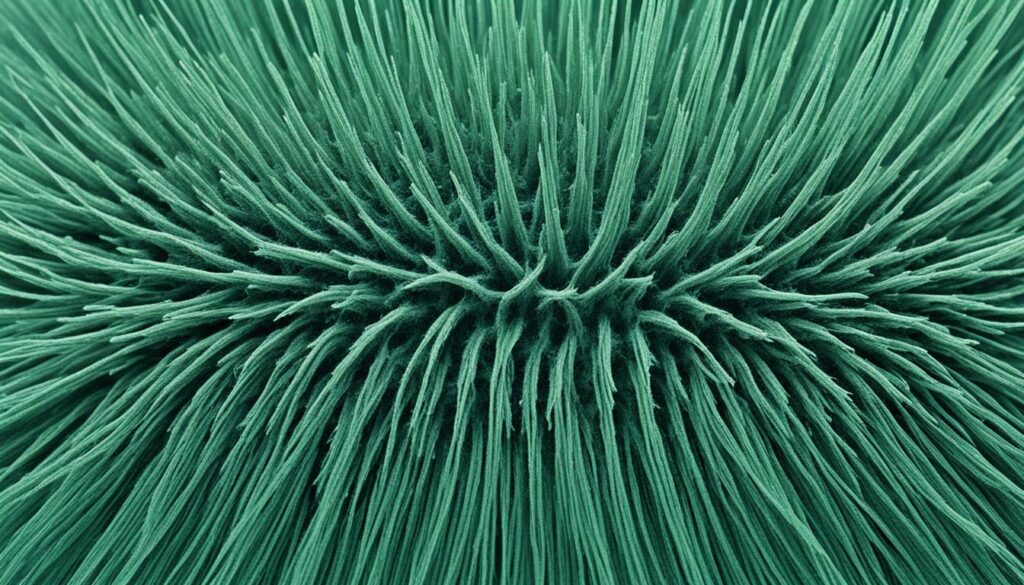
Hair Mold Causes and Prevention Tips | Expert Guide
Welcome to our expert guide on hair mold, where we will explore the causes of hair mold and provide valuable tips on how to prevent it. Hair mold can be a persistent problem, causing damage to both your hair and the environment it thrives in. By understanding the causes and taking proactive measures, you can maintain a mold-free living space and promote healthy hair growth.
Key Takeaways:
- Understanding the causes of hair mold is essential to prevent its recurrence.
- Maintaining proper ventilation and controlling moisture levels can help prevent hair mold growth.
- Regular inspections and professional assistance can aid in the detection and removal of hair mold.
- Implementing preventive measures can safeguard your health and ensure a mold-free environment.
- Staying proactive with hair mold prevention is crucial for maintaining healthy hair and a safe living space.
Understanding Hair Mold
In this section, we will delve deeper into the nature of hair mold. We will discuss how it grows, the conditions it thrives in, and the potential health risks associated with exposure to hair mold. Having a clear understanding of hair mold will enable you to identify and address any problems effectively.

The growth of hair mold is a common occurrence in damp environments. When hair is exposed to high levels of moisture, it creates an ideal breeding ground for mold spores to thrive. Mold growth is facilitated by the presence of organic material, such as dead skin cells or hair products, which provide a food source for mold to feed on.
Humidity and poor ventilation contribute to the development of hair mold. Areas with high humidity levels, such as bathrooms or poorly ventilated rooms, are particularly susceptible to mold growth. Mold tends to thrive in warm and humid conditions, where it can spread rapidly if left unaddressed.
The Risks of Hair Mold Exposure
The presence of hair mold can pose various health risks to individuals. Exposure to mold spores can trigger allergic reactions, respiratory issues, and even infections. People with pre-existing respiratory conditions, such as asthma or allergies, are especially vulnerable to the harmful effects of mold.
Additionally, prolonged exposure to hair mold can lead to long-term health complications. These may include chronic sinus infections, bronchitis, or even the development of mold-related illnesses. It is crucial to recognize the signs of hair mold growth and take immediate action to mitigate its impact on your health and well-being.
“Hair mold poses potential health risks and should not be ignored. Understanding its growth patterns and the conditions it thrives in is key to effective prevention and removal.”
Identifying Hair Mold
Detecting hair mold early is essential for preventing its spread and minimizing its impact. Key signs of hair mold growth include musty odors, visible discoloration on hair or scalp, and an increase in skin irritations or respiratory symptoms in the affected person.
If you suspect the presence of hair mold, it is crucial to take immediate action to address the issue. Thoroughly clean and dry the affected areas, ensuring proper ventilation and reducing moisture levels. If the mold growth persists or covers a large area, seek professional assistance to ensure safe and effective removal.
Preventing Hair Mold
Preventing hair mold is crucial to maintaining a clean and healthy environment. By implementing a few key strategies, you can effectively reduce the risk of mold growth and keep your space mold-free. In this section, we will explore expert tips for hair mold prevention, focusing on the importance of proper ventilation, moisture control, and regular inspections.
1. Ensure Proper Ventilation
Adequate ventilation plays a significant role in preventing hair mold. Proper airflow helps to minimize moisture buildup, ultimately creating an unfavorable environment for mold growth. Here are a few steps you can take to improve ventilation:
- Open windows and doors to encourage fresh air circulation.
- Use exhaust fans in bathrooms, kitchens, and laundry rooms to remove excess moisture.
- Install vents in humid areas, such as attics, crawl spaces, and basements.

2. Control Moisture Levels
Mold thrives in damp and humid environments, so controlling moisture is essential in preventing hair mold. Here are some tips to help you maintain optimal moisture levels:
- Fix any leaks or water damage promptly.
- Use dehumidifiers in areas with high humidity.
- Ensure proper insulation to prevent condensation.
- Keep surfaces dry and clean by wiping off any excess moisture.
3. Regular Inspections
Regular inspections are vital in identifying early signs of hair mold and preventing its spread. Here’s what you should do:
- Regularly check areas prone to moisture, such as bathrooms, kitchens, and basements.
- Look for visible signs of mold growth, such as discoloration or a musty odor.
- Inspect your hair care products and tools for any signs of mold contamination.
- Consider hiring a professional mold removal service for a thorough inspection if needed.
By following these expert tips for hair mold prevention, you can create a safe and mold-free environment. Remember, proper ventilation, moisture control, and regular inspections are key to keeping your space free from hair mold and its potential health risks.
Conclusion
Preventing hair mold is essential for maintaining a healthy living space. By following these mold prevention tips and taking proper care of your hair, you can minimize the risks associated with hair mold and create a mold-free environment. Remember, prevention is always better than dealing with the consequences of mold growth.
To effectively combat hair mold, it is crucial to understand its causes. Excessive moisture, lack of ventilation, and prolonged exposure to damp environments can contribute to mold growth. By addressing these underlying issues, such as fixing leaks and promoting airflow, you can significantly reduce the chances of hair mold developing.
Regular inspections are key to early detection and prevention of hair mold. Be vigilant in checking for any signs of mold growth, such as musty odors or discoloration on surfaces. If you spot any indications of mold, take immediate action to remove it safely and effectively. Seeking professional assistance will ensure thorough mold removal and proper care.
By adopting these mold prevention tips and embracing good hair care practices, you can safeguard your living space from hair mold. Remember to maintain a clean and dry environment, promote ventilation, and address any potential issues promptly. With these proactive measures in place, you can enjoy healthy and mold-free surroundings.




